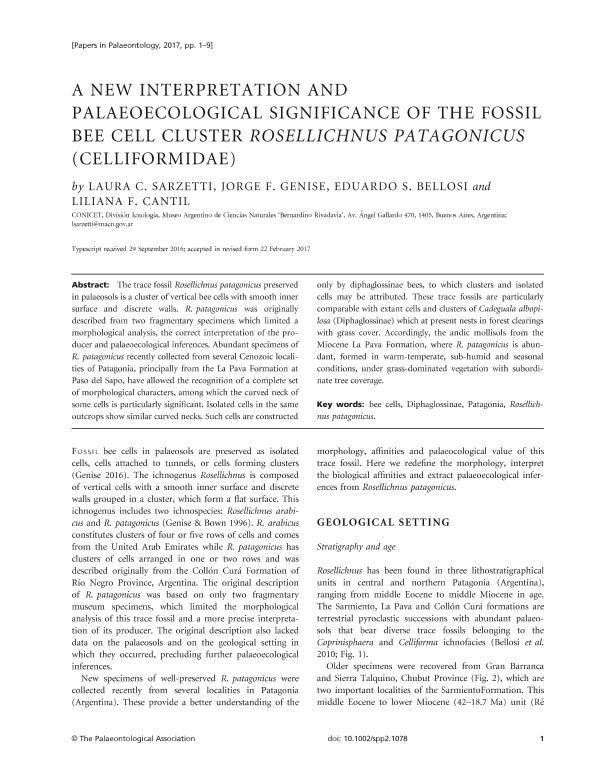Mostrar el registro sencillo del ítem
dc.contributor.author
Sarzetti, Laura Cristina

dc.contributor.author
Genise, Jorge Fernando

dc.contributor.author
Bellosi, Eduardo Sergio

dc.contributor.author
Cantil, Liliana Fernanda

dc.date.available
2018-06-07T20:30:25Z
dc.date.issued
2017-08
dc.identifier.citation
Sarzetti, Laura Cristina; Genise, Jorge Fernando; Bellosi, Eduardo Sergio; Cantil, Liliana Fernanda; A new interpretation and palaeoecological significance of the fossil bee cell cluster Rosellichnus patagonicus (Celliformidae); Wiley Blackwell Publishing, Inc; Papers in Palaeontology; 3; 3; 8-2017; 363-371
dc.identifier.issn
2056-2802
dc.identifier.uri
http://hdl.handle.net/11336/47781
dc.description.abstract
The trace fossil Rosellichnus patagonicus preserved in palaeosols is a cluster of vertical bee cells with smooth inner surface and discrete walls. R. patagonicus was originally described from two fragmentary specimens which limited a morphological analysis, the correct interpretation of the producer and palaeoecological inferences. Abundant specimens of R. patagonicus recently collected from several Cenozoic localities of Patagonia, principally from the La Pava Formation at Paso del Sapo, have allowed the recognition of a complete set of morphological characters, among which the curved neck of some cells is particularly significant. Isolated cells in the same outcrops show similar curved necks. Such cells are constructed only by diphaglossinae bees, to which clusters and isolated cells may be attributed. These trace fossils are particularly comparable with extant cells and clusters of Cadeguala albopilosa (Diphaglossinae) which at present nests in forest clearings with grass cover. Accordingly, the andic mollisols from the Miocene La Pava Formation, where R. patagonicus is abundant, formed in warm‐temperate, sub‐humid and seasonal conditions, under grass‐dominated vegetation with subordinate tree coverage.
dc.format
application/pdf
dc.language.iso
eng
dc.publisher
Wiley Blackwell Publishing, Inc

dc.rights
info:eu-repo/semantics/openAccess
dc.rights.uri
https://creativecommons.org/licenses/by-nc-sa/2.5/ar/
dc.subject
Bee Cells
dc.subject
Diphaglossinae
dc.subject
Patagonia
dc.subject
Rosellichnus Patagonicus
dc.subject.classification
Meteorología y Ciencias Atmosféricas

dc.subject.classification
Ciencias de la Tierra y relacionadas con el Medio Ambiente

dc.subject.classification
CIENCIAS NATURALES Y EXACTAS

dc.title
A new interpretation and palaeoecological significance of the fossil bee cell cluster Rosellichnus patagonicus (Celliformidae)
dc.type
info:eu-repo/semantics/article
dc.type
info:ar-repo/semantics/artículo
dc.type
info:eu-repo/semantics/publishedVersion
dc.date.updated
2018-06-04T13:53:07Z
dc.journal.volume
3
dc.journal.number
3
dc.journal.pagination
363-371
dc.journal.pais
Reino Unido

dc.journal.ciudad
Londres
dc.description.fil
Fil: Sarzetti, Laura Cristina. Consejo Nacional de Investigaciones Científicas y Técnicas. Oficina de Coordinación Administrativa Parque Centenario. Museo Argentino de Ciencias Naturales "Bernardino Rivadavia"; Argentina
dc.description.fil
Fil: Genise, Jorge Fernando. Consejo Nacional de Investigaciones Científicas y Técnicas. Oficina de Coordinación Administrativa Parque Centenario. Museo Argentino de Ciencias Naturales "Bernardino Rivadavia"; Argentina
dc.description.fil
Fil: Bellosi, Eduardo Sergio. Consejo Nacional de Investigaciones Científicas y Técnicas. Oficina de Coordinación Administrativa Parque Centenario. Museo Argentino de Ciencias Naturales "Bernardino Rivadavia"; Argentina
dc.description.fil
Fil: Cantil, Liliana Fernanda. Consejo Nacional de Investigaciones Científicas y Técnicas. Oficina de Coordinación Administrativa Parque Centenario. Museo Argentino de Ciencias Naturales "Bernardino Rivadavia"; Argentina
dc.journal.title
Papers in Palaeontology
dc.relation.alternativeid
info:eu-repo/semantics/altIdentifier/url/https://onlinelibrary.wiley.com/doi/abs/10.1002/spp2.1078
dc.relation.alternativeid
info:eu-repo/semantics/altIdentifier/doi/https://dx.doi.org/10.1002/spp2.1078
Archivos asociados
